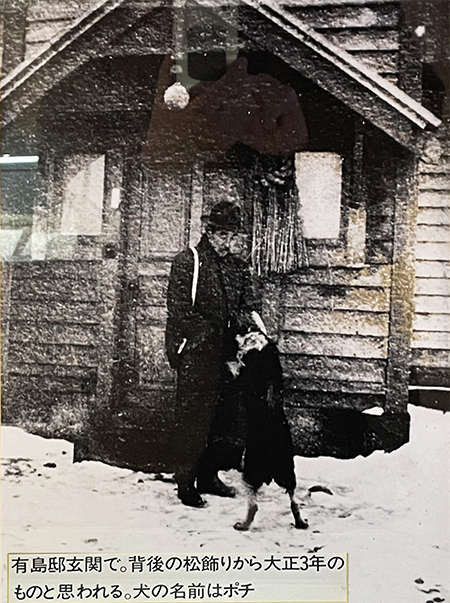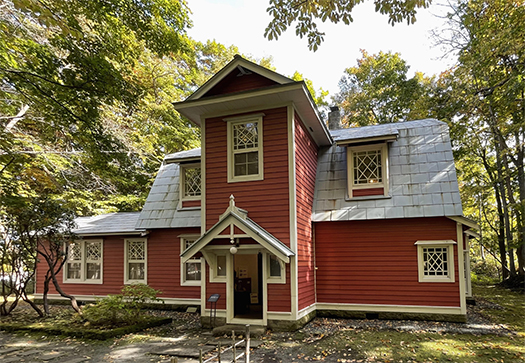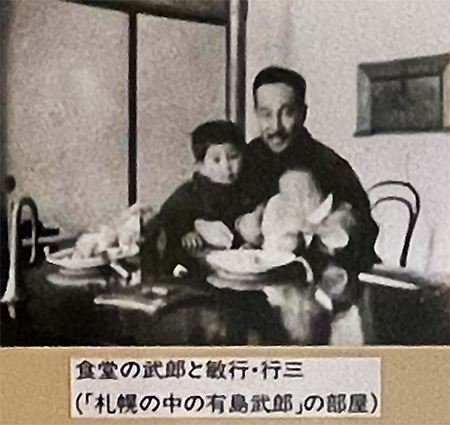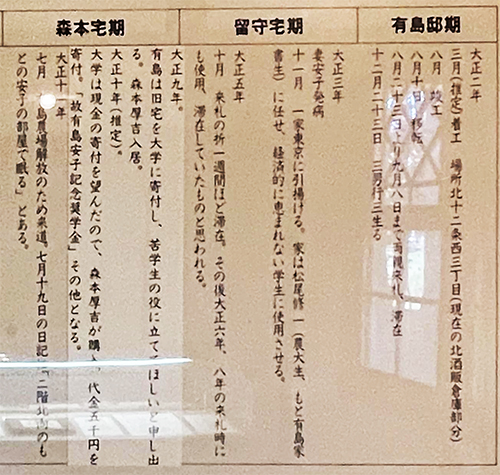

文学者の人生というのは、一定の個人情報ではあるけれど「私小説」というジャンルが成立しているように、そういう丸ごとを表現して読者と交感しているような側面があり、遺族などの同意を前提に公開されている情報なのでしょう。ただ、日本人の作家はそういう条件を同意して活動した結果、芥川龍之介とか、太宰治とか、自死を遂げる結果を迎えるひとが多い。有島もその轍を踏んだ。
しかしそれらの情報公開によって、そういう部分も含めて一般読者としては作品世界を感受することが出来るという意味では、味読の領域が拡大するものでしょう。さらに現代ではたくさんの非文章的な写真とか資料記録などが残っていくので、さらに消息を深く探究していくことができる。
上の写真はこの有島邸が完成し一家が入居した翌年の大正3年の正月の玄関先での様子。「ポチ」という作家らしからぬ一般普通名称を名付けられた(笑)愛犬が有島にじゃれついている。有島とイキモノとしてその心を交流させたに違いない愛犬の様子がなまなましく伝わってきて、ほっとさせられる。
西郷隆盛と愛犬のエピソードは日本人に広く伝わっているけれど、そのことが生前の人物像に血を通わせてくれる。そういうのが日本人はとくに好きなのかも知れない。いちばんアングル的にぴったりな外観写真と合わせてごらんください。また、この大正3年の正月の札幌市内の積雪状況もその空気感・リアリティが印象的に伝わってくる。


そして新居でうまれた子どもを抱擁しながらの人の親としての有島のワンショット。札幌を深く愛してこの地で大学教官としての職も得て、そして自らの「創造性」も投影させた注文住宅を建てて、いわば人生の幸せのピークを迎えていたといえるのでしょう。
下の年表は有島とその家族、そしてこの戸建て住宅がどのような数奇な運命をたどったのかを表現したものの一部。この家で有島家が正月を迎えられたのはたった1年に過ぎない。最愛の奥さんが新築2年目で病気を発症して以降のこの家の状況が記録されている。
きのうも触れたけれどこの当時の「住宅経済」の一端を推し量れる数字もある。大正10年(1921年)当時、坪数80坪近い大型住宅が5,000円で取引されている。昨日探究した金銭感覚の翻訳コンニャク(購買率平価基準として×1,080)を当てると現代平価では5,400,000円となる。土地は借地とであり建築本体価格だけということなので、これは一定のモノサシではあるのだろうか。築後7年であり、当時の土地感覚では「ジメジメした」とされる札幌駅北側の敷地条件なども勘案すると蓋然性は感じる。創成川開削などによる土地改良事業はまだ道半ばだった。
やはり表現の仕事をしてくれた先人の足跡からはいろいろな情報を受け取ることができる。後世の人間としては深く感謝するしかありませんね。
English version⬇
The Fate of the House, the People, and Life: The Former Residence of Takeo Arishima-8
The sheer joy of life, blessed with three children, took a dark turn. His beloved wife became ill and died too young. The house still tells us of Mr. Arishima’s thoughts and breath. The house still speaks of Mr. Arishima’s thoughts and breath.
The lives of literary figures are a certain amount of personal information, but just as the genre of “private novels” has been established, there is an aspect of expressing the entirety of a literary figure’s life and communicating it to readers, and this information is made public on the premise of consent from the bereaved family. However, many Japanese writers, such as Ryunosuke Akutagawa and Osamu Dazai, committed suicide as a result of having agreed to such conditions. Arishima followed in their footsteps.
However, the disclosure of such information will expand the realm of reading in the sense that the general reader will be able to perceive the world of the work, including such aspects of the work. In addition, today, there are many unwritten photographs and records of materials left behind, so it is possible to explore the history of the work even more deeply.
The photo above is a scene at the entrance of the Arishima residence on New Year’s Day in 1914, the year after the residence was completed and the family moved in. Pochi,” the dog that was given the common name of “Pochi,” which is not like the artist (laugh), is playing with Arishima. The dog, which must have communicated with Arishima as an animate being, is affectionate and relaxed.
The episode of Saigo Takamori and his beloved dog is widely known among Japanese people, and it brings blood to the image of the man before his death. Perhaps Japanese people are particularly fond of such things. Please take a look at the photo of the exterior of the building, which is the best angle of the building. The snowfall in Sapporo on New Year’s Day in 1914 also conveys the atmosphere and reality of the city.
And here is a shot of Arishima as a parent embracing his newborn child in his new home. He was deeply in love with Sapporo, had obtained a job as a university professor here, and had built a custom-built house that reflected his own “creativity,” so to speak, and was at the peak of happiness in his life.
The timeline below is part of the story of Arishima, his family, and the fate of this detached house. The Arishima family celebrated New Year’s in this house for only one year. The house’s condition is recorded after the beloved wife became ill in the second year after the house was built.
As I mentioned yesterday, there are some figures that give an idea of the “housing economy” at that time. In 1921, a large house with a floor space of nearly 80 tsubo (about 1,000 square meters) was priced at 5,000 yen. If we apply the monetary translation konnyaku (purchasing rate parity standard x 1,080) that we explored yesterday, the price would be 5,400,000 yen in modern parity. Since the land is leased and only the price of the building itself is used, I wonder if this is a certain measure. The property was built seven years ago, and the site conditions on the north side of Sapporo Station, which was considered “gloomy” according to the land sense of the time, are also taken into account. Land improvement projects, such as the Sosegawa River excavation, were still in their infancy.
After all, we can receive a variety of information from the footsteps of our predecessors who did the expressive work. As a person of the future generation, I can only be deeply grateful.
Posted on 10月 23rd, 2023 by 三木 奎吾
Filed under: 住宅マーケティング, 日本社会・文化研究







コメントを投稿
「※誹謗中傷や、悪意のある書き込み、営利目的などのコメントを防ぐために、投稿された全てのコメントは一時的に保留されますのでご了承ください。」
You must be logged in to post a comment.